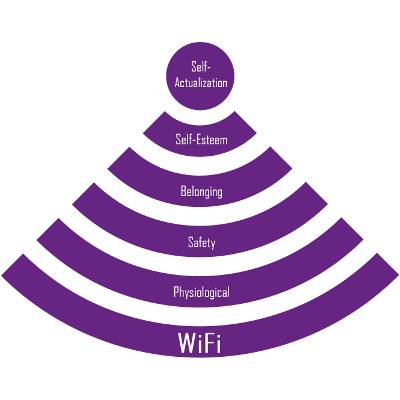 In 1943, psychologist Abraham Maslow published a paper about human motivation that would become the well-known Maslow's Hierarchy of Needs. His theory states that before self-actualization can be achieved, four needs must first be met, like esteem, belonging, safety, and physiological (the most basic which includes, air, food, water, etc.). In 2014, we feel the need to add one more layer to Maslow's pyramid: WiFi.
In 1943, psychologist Abraham Maslow published a paper about human motivation that would become the well-known Maslow's Hierarchy of Needs. His theory states that before self-actualization can be achieved, four needs must first be met, like esteem, belonging, safety, and physiological (the most basic which includes, air, food, water, etc.). In 2014, we feel the need to add one more layer to Maslow's pyramid: WiFi.
In actuality, humans probably don't need WiFi more than breathable air, but it is a reality that technology users need access to a reliable WiFi connection in order to check notifications from their favorite websites. Before these users can come up with the psychological fortitude to get any work done, much less arrive at self-actualization, they need to check these notifications via WiFi. Yep, we're addicted to the Internet. This WiFi dependent condition has the feel of a physiological disorder, and if Maslow were alive today, he would prescribe a remedy that would satisfy this most fundamental need of modern patients, faster WiFi.
The benefits of a faster Internet connection for any business will help to actualize greater profits. For example, the promise of a faster Internet is why many startup entrepreneurs flocked to Kansas City when Google announced in 2011 that the Midwestern city would be the testing ground for its new Google Fiber service, which is a fiber-to-the-premises service that offers customers Internet speeds of 1 Gbit/s. Those of us without Google Fiber can only daydream about all of the projects that can be accomplished with a 1 Gbit/s Internet connection, especially via WiFi.
Many of us may have less than 100 Mbps of upload and download speeds for our office, which is adequate for basic tasks such as Internet browsing and email on your mobile device, but for enterprises with more ambitious mobile plans, they will want to take advantage of cloud services for hosting business applications and storing data. Cloud computing gives everyone on your staff wireless access to mission-critical applications via the cloud from mobile devices, which will improve your company's mobility, productivity, and profitability. If your company's WiFi signal is weak, then you will be limited by how many wireless solutions like cloud computing your business can take advantage of.
Currently, the fastest wireless router on the market is 802.11ac. This has an advertised speed of 1.3 Gbps, which means that the actual working speed is more like 400-to-800 Mbps. For all practical purposes, that's fast; much faster than the routers of just a few years ago. However, even a fast signal like 802.11ac can still experience strain from a medium-sized company where multiple employees are participating in web conferences on their mobile devices.
The next generation of Wi-Fi technology is on the way and it promises to ramp up speeds by as much as 10 times the current 802.11ac routers! We're talking WiFi data rates of up to 7 Gbps in the 5 GHz band with IEEE 802.11ac-2013. According to IEEE, 802.11ac-2013 "adds channel bandwidths of 80 MHz and 160 MHz with both contiguous and non-contiguous 160 MHz channels for flexible channel assignment." This is technical talk to say that broader channels are being used to deliver data faster.
One of the ways that this ludicrous speed is achieved is with new Beamforming Technology, which concentrates the WiFi signal into a direct beam to the device, instead of sending out the signal in a broad circular pattern. To ensure that there is no wireless traffic jams from multiple devices, IEEE has a new technology that supports "multiple concurrent down-link transmissions, referred to as 'multi-user multiple-input, multiple-output' (MU MIMO). By using smart antenna technology, MU MIMO enables more efficient spectrum use, higher system capacity and reduced latency by supporting up to four simultaneous user transmissions. This is particularly useful for client devices with a limited number of antennas, such as smartphones and tablets."
This 802.11ac-2013 technology is predicted to be released by the end of 2014, and Bruce Kraemer, chair of the IEEE 802.11 working group, expects it "to help users' transition application from fixed links to the convenience, freedom, and versatility of wireless links." In short, faster is better, and faster wireless signal is will allow your company to grow faster.
In the Hierarchy of Needs Pyramid for your business, WiFi and your IT infrastructure would make up the pyramid's base. This is because your business runs on data, and without reliable access to your company's data, your work day would be ruined and productivity would crash to a halt. Using technology to actualize the goals of your business is the working theory of XFER. Give us a call at 734-927-6666 / 800-GET-XFER and let us prescribe you a solution that will meet all of your business needs.
![]()

